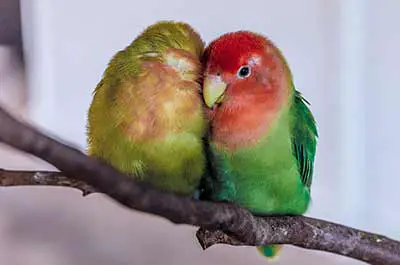Lead a busy lifestyle and no time for a pet? Look no further than lovebirds! These tiny birds are perfect for busy people.
Low-maintenance and easily tamed, lovebirds are sociable companions that delight in their playful antics.
Need a lively and lovable friend? Meet lovebirds! These feathery companions effortlessly bring beauty with vibrant plumage and a charming presence. Renowned for delightful chirps, lovebirds brighten your day with lovable antics and affectionate personalities. Get ready for a world of feathered fun!
What are lovebirds, and where do they come from?
Lovebirds are small, brightly colored parrots that are native to Africa. Lovebirds, charmingly named for their affectionate behavior of sitting close and gently grooming each other’s feathers, showcase tender expressions of love. These social creatures thrive in pairs or small communities, where their affectionate nature truly shines.
Did you know there are nine captivating species of lovebirds, each with its own vibrant palette? From emerald green to shades of blue, yellow, and orange, these delightful avian companions are gaining popularity as pets worldwide. Lovebirds are also known for their melodious calls, which can be heard from impressive distances of up to half a mile away. Experience their charm, mesmerizing melodies, and vibrant presence in any living space!
In the wild, these creatures thrive on a diverse diet of fresh fruits, vegetables, high-quality seeds, and specially formulated pellets. Proper care, socialization, and an environment that meets their needs help them blossom into amazing, affectionate companions, bringing joy and love to their human counterparts.
Why are lovebirds a popular choice for people looking for a new pet?

When selecting a new pet, people often seek a friendly, low-maintenance, and affectionate animal. Lovebirds perfectly fit the bill.
These small parrots are loved for their companionship and gentle nature.
As a result, they make great pets for families with young children:
First, they’re small and easy to care for. They also have a reputation for being affectionate and forming strong bonds with their owners.
They have vibrant plumage, adding a colorful touch to any home. They are also playful and curious, making them delightful companions.
If you want a low-maintenance yet entertaining pet, consider a lovebird.
What to consider before getting a lovebird?
Considering a lovebird? Keep a few things in mind:
Lovebirds thrive on social interaction and crave companionship from their feathery friends or beloved humans. Confining them in a cage all day is unfair, as these vibrant creatures are meant to spread their wings and experience the world. Let’s give them the love and attention they deserve!
Lovebirds are noisy! If you want a quiet pet, lovebirds aren’t the best option. They love to chirp and tweet, and they can get pretty loud.
Lovebirds are active and require ample space to fly and explore. A small cage won’t suffice, so ensure you have a large enough cage or aviary for them to stretch their wings.
Lovebirds can live up to 20 years! Ensure you’re prepared for the long-term commitment before getting one.
Find a reputable breeder or pet store for a healthy, well-socialized bird. With some preparation, you’ll be ready to welcome your new feathered friend home in no time!
What are some of the best things about owning a lovebird?
One of the best things about having a lovebird is their companionship. These social creatures thrive on interaction and attention.
Lovebirds are playful, offering hours of entertainment. They are low-maintenance and easy to care for as pets.
Choose from a variety of colors to find a lovebird that matches your style. There’s a lovebird for everyone, ranging from bright greens to vibrant oranges.
Lovebirds are a delight to watch! They’re energetic, full of personality, and always up for a game of catch. They even imitate their owners. Watching these playful birds will surely bring a smile to your face.
How to Choose a Lovebird?
Choosing a lovebird can be tricky. They have unique personalities, so finding a compatible one is important.
Here are a few things to keep in mind when choosing a lovebird:
- Consider what you want in a companion. A lively and energetic bird or a more calm one?
- Consider the bird size you want. Lovebirds have two sizes: peach-faced and Fischer’s. Peach-faced lovebirds are larger, reaching up to six inches. Fischer’s lovebirds are smaller, around four to five inches long.
- Consider the color you desire for your bird. Lovebirds come in various hues, ranging from vibrant green to soft blue. If you have a specific color preference, research breeders who specialize in it.
- Consider your lifestyle. Lovebirds are highly active and require ample space for flying and exploring. If you live in a small apartment, it’s advisable to choose a bird species more suitable for cage living.
- Consider the cost. Lovebirds can be expensive, so analyze them before buying. Keep these points in mind to find your perfect lovebird.
How to Care for Your Lovebird?
After choosing your lovebird, it’s crucial to learn proper care for your new pet. Follow these tips to get started:
- Provide a spacious cage or aviary for lovebirds. They thrive when they have plenty of room to fly and explore, so ensure their enclosure allows them freedom of movement.
- Place the cage in a quiet area. Lovebirds are social creatures and need interaction, but they also appreciate peace. Choose a location away from loud noises and commotion.
- Give your bird plenty of toys. Lovebirds are playful and need stimulation to stay happy. Provide your bird with different toys, including chew toys, swing toys, and mirror toys.
- Offer fresh food and water daily. Lovebirds thrive on a diet of pellets, seeds, and veggies. Remember to clean the cage regularly to prevent bacterial buildup.
How to Train a Lovebird to do Tricks?
Lovebirds are very playful and easy to train. Here are a few tips to get you started:
- Start with basic commands. Lovebirds can be taught to respond to a variety of commands, including “come,” “stay,” “sit,” and “roll over.” Work your way up to more complicated tricks as your bird becomes more comfortable with the training.
- Keep training sessions short. Lovebirds have a short attention span, so it’s important to keep training sessions short and sweet. Aim for five to ten minutes at a time
- Use positive reinforcement. Whenever your bird performs a trick correctly, give it a treat or praise it lavishly. This will help your bird learn the trick faster and make training a fun experience for both of you.
- Be patient. Training a lovebird can take time, so be patient and practice regularly. With a little patience and persistence, you’ll have your lovebird performing tricks like a pro in no time!
Ways to bond with your lovebird.
Here are a few ideas to help you bond with your lovebird:
- Spend time together every day. Bond with your lovebird by spending daily time together.
- Talk to your bird, offer it bits of food from your plate, and let it perch on your finger or shoulder. The more you’re together, the stronger your bond becomes.
- Take your bird out of its cage. Lovebirds are social and curious. Take them out of the cage to fly around or play with toys. Always supervise to prevent mischief.
- Play together. Lovebirds enjoy playing, so take time out of your day to engage in simple games like fetch or hide-and-seek. Bond with your bird and have fun!
Fun activities to do with your lovebird.
There are a variety of fun activities that you can do with your lovebird to keep them happy and healthy.
- One fun activity is taking your lovebird outside to enjoy fresh air and sunshine. They will love playing in the grass and exploring. Keep an eye on them, as they may try to fly off if they get too excited.
- Bath your lovebird. Lovebirds love bathing and preening, making it a great bonding activity while keeping them clean. Fill a sink or container with warm water and let them splash away!
- Another option is to play games with them. Hide favorite toy in the house and see if they can find it. Or put a treat in a paper towel roll and watch them try to get it out. Your lovebird will have a blast, and you’ll get some laughs too.
Lovebird health.
Lovebirds are small, affectionate parrots that make great pets. However, like all birds, they can experience health issues such as obesity, feather-plucking, and respiratory infections.
- Obesity is common in lovebirds, who tend to overeat. This can cause health issues like heart disease and joint problems. To prevent obesity, monitor your lovebird’s diet and ensure enough exercise.
- Feather-plucking is a common issue in pet lovebirds. It can be due to boredom, stress, or poor nutrition. If your lovebird plucks its feathers, take them to the vet to rule out medical causes. After excluding underlying issues, you can try addressing the problem with behavioral modification techniques.
- Pet lovebirds frequently experience respiratory infections caused by bacteria or viruses, which can be fatal if left untreated. If you observe coughing, sneezing, or unusual lethargy in your lovebird, promptly seek veterinary care.
Here are some key considerations for lovebird health. By staying informed about potential issues and taking preventive measures, you can ensure a long and healthy life for your lovebird.
Conclusion.
Lovebirds are amazing pets that bring joy to your life. However, like all birds, they need special care. By monitoring their health and giving them love and attention, your lovebird can thrive. Thanks for reading!

Meet Marcella Raskin: Founder, Editor-in-Chief, and a Maven in Human Potential
Dive into the rich tapestry of Marcella Raskin’s life and you’ll discover more than just an editor-in-chief. At the core, Marcella is a passionate writer, deeply committed to unlocking the boundless human potential. Armed with expertise in Cognitive Behavioral Therapy, Life Purpose Coaching, and Group Life Coaching, she’s carved a niche in helping both women and men unearth their true selves through the art of writing. Every article she pens is a gateway, inviting readers to shift mindsets and embrace transformation, even when change seems impossible.
Beyond her literary pursuits, Marcella is a fitness enthusiast, underpinned by her background in Exercise Physiology. And when she’s not empowering others or delving into the science of movement, she’s reveling in the joys of motherhood, raising two incredible girls, and sharing life’s moments with her beloved spouse.
Trust Marcella’s words; they’re backed by expertise, passion, and a journey full of learning and growth.
Reviewed By: Joanna Perez and Brenda Tillman
Edited By: Lenny Terra
Fact Checked By: Matthew Mansour
Photos Taken or Curated By: Matthew Mansour